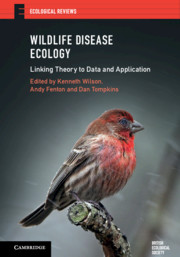Book contents
- Wildlife Disease Ecology
- Ecological Reviews
- Wildlife Disease Ecology
- Copyright page
- Contents
- Contributors
- Preface: Wildlife Disease Ecology
- Glossary of Terms
- Part I Understanding within-host processes
- Part II Understanding between-host processes
- Chapter Eight Using insect baculoviruses to understand how population structure affects disease spread
- Chapter Nine Infection and invasion: study cases from aquatic communities
- Chapter Ten Parasite-mediated selection in red grouse – consequences for population dynamics and mate choice
- Chapter Eleven Emergence, transmission and evolution of an uncommon enemy: Tasmanian devil facial tumour disease
- Chapter Twelve Bovine tuberculosis in badgers: sociality, infection and demography in a social mammal
- Chapter Thirteen Mycoplasma ovipneumoniae in bighorn sheep: from exploration to action
- Chapter Fourteen Manipulating parasites in an Arctic herbivore: gastrointestinal nematodes and the population regulation of Svalbard reindeer
- Part III Understanding wildlife disease ecology at the community and landscape level
- Index
- Plate Section (PDF Only)
- References
Chapter Thirteen - Mycoplasma ovipneumoniae in bighorn sheep: from exploration to action
from Part II - Understanding between-host processes
Published online by Cambridge University Press: 28 October 2019
- Wildlife Disease Ecology
- Ecological Reviews
- Wildlife Disease Ecology
- Copyright page
- Contents
- Contributors
- Preface: Wildlife Disease Ecology
- Glossary of Terms
- Part I Understanding within-host processes
- Part II Understanding between-host processes
- Chapter Eight Using insect baculoviruses to understand how population structure affects disease spread
- Chapter Nine Infection and invasion: study cases from aquatic communities
- Chapter Ten Parasite-mediated selection in red grouse – consequences for population dynamics and mate choice
- Chapter Eleven Emergence, transmission and evolution of an uncommon enemy: Tasmanian devil facial tumour disease
- Chapter Twelve Bovine tuberculosis in badgers: sociality, infection and demography in a social mammal
- Chapter Thirteen Mycoplasma ovipneumoniae in bighorn sheep: from exploration to action
- Chapter Fourteen Manipulating parasites in an Arctic herbivore: gastrointestinal nematodes and the population regulation of Svalbard reindeer
- Part III Understanding wildlife disease ecology at the community and landscape level
- Index
- Plate Section (PDF Only)
- References
Summary
Some of the greatest successes in infectious disease control rest on empirically grounded models of human and livestock infections. In contrast, disease control in wildlife has not always been as successful. Timely translation of knowledge into proposed management actions remains a challenge in several wildlife disease systems, one of which is pneumonia management in bighorn sheep throughout the North American West. Although pneumonia was recognised as a major impediment to bighorn sheep conservation >80 years ago, a series of challenges stymied the management decision-making process. Despite past obstacles, recent advances from long-term, intensive studies of marked individual sheep have motivated new interest in research-driven strategies for disease management in this system. The system provides an unusual opportunity to study an emerging pathogen disproportionately impacting immature animals through infections that originate from asymptomatically infected adult hosts. We tell the story of bighorn sheep pneumonia, emphasising the obstacles that historically hindered decision-making, the biological or logistical constraints underlying each decision point, and the particular empirical insights that clarified each constraint.
Keywords
- Type
- Chapter
- Information
- Wildlife Disease EcologyLinking Theory to Data and Application, pp. 368 - 396Publisher: Cambridge University PressPrint publication year: 2019
References
- 1
- Cited by



